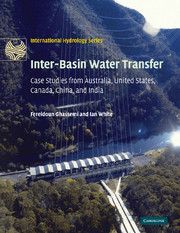Book contents
- Frontmatter
- Contents
- Foreword
- Overview and Scope
- Acknowledgements
- List of Abbreviations
- Part I The Challenges
- Part II Inter-basin Water Transfer in Australia
- 3 Land and water resources of Australia
- 4 The Snowy Mountains hydro-electric scheme
- 5 Inter-basin water transfer from coastal basins of New South Wales
- 6 The Bradfield and Reid schemes in Queensland
- 7 Three schemes for flooding Lake Eyre
- 8 The Goldfields pipeline scheme of Western Australia
- 9 Supplying Perth, Western Australia with water: the Kimberley pipeline scheme
- 10 Other schemes in Australia
- Part III Inter-basin Water Transfer in Other Selected Countries
- Part IV Appendices
- Glossary
- Index
- References
5 - Inter-basin water transfer from coastal basins of New South Wales
Published online by Cambridge University Press: 05 November 2009
- Frontmatter
- Contents
- Foreword
- Overview and Scope
- Acknowledgements
- List of Abbreviations
- Part I The Challenges
- Part II Inter-basin Water Transfer in Australia
- 3 Land and water resources of Australia
- 4 The Snowy Mountains hydro-electric scheme
- 5 Inter-basin water transfer from coastal basins of New South Wales
- 6 The Bradfield and Reid schemes in Queensland
- 7 Three schemes for flooding Lake Eyre
- 8 The Goldfields pipeline scheme of Western Australia
- 9 Supplying Perth, Western Australia with water: the Kimberley pipeline scheme
- 10 Other schemes in Australia
- Part III Inter-basin Water Transfer in Other Selected Countries
- Part IV Appendices
- Glossary
- Index
- References
Summary
INTRODUCTION
Some of the coastal New South Wales rivers appear to have the potential for diverting part of their flow into the inland basins. However, the New South Wales Department of Infrastructure, Planning and Natural Resources (DIPNR) has no plans for inter-basin water transfer for the near future, although the Department's current water sharing policy under the Water Management Act 2000 (DLWC, 2001) does not exclude inter-basin water transfer.
Out of 22 coastal river basins in NSW, only nine have their western boundaries on the Great Dividing Range and are suitably located for inland water diversion (Figure 5.1). Five of these basins: the Hunter (II-10), Hawkesbury (II-12), Shoalhaven (II-15), Bega (II-19), and Snowy (II-22) do not have excess water for diversion (Water Resources Commission of NSW, 1981, Table 3.1).
In the absence of recent published data for the NSW river basins (National Land & Water Resources Audit, 2001, Appendix 1), Table 5.1 provides characteristics of the four remaining basins in 1983–84. It indicates that water use in these basins (from both surface and groundwater resources) was less than one percent of their respective average annual run-off. Assuming doubling water consumption since 1984 and further doubling in the following two decades, and ignoring the environmental flow requirements, it seems that a considerable volume of water may be uncommitted in these basins for possible inland diversion. However, the issue is far more complex because of the high cost, environmental concerns and opposition of the community to large-scale inland water transfer projects.
- Type
- Chapter
- Information
- Inter-Basin Water TransferCase Studies from Australia, United States, Canada, China and India, pp. 107 - 124Publisher: Cambridge University PressPrint publication year: 2007

